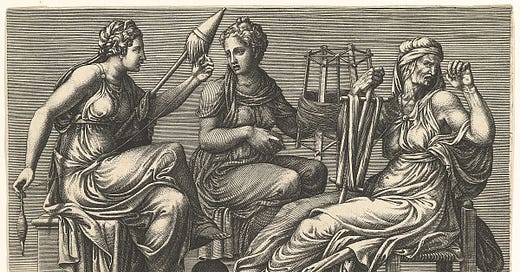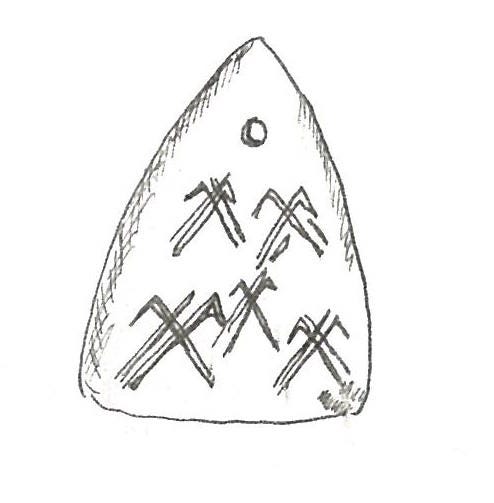“Our hands remember…
how to gather what’s been scattered.
how to spin beauty from chaos.
how to weave new worlds into being.
how to make magic together.”
-Hanna Leigh, from the WE ARE THE WEAVERS upcoming course, starting March 12th

Since I was a girl, I’ve been enchanted by the intertwining magic of stories and spun threads. Of texts and textiles. Of women who spin both fates and songs, clouds and cloth, of knot-magic that can harness storms at sea and unknot pain in the soul. I learned to knit around the same time I first started to write stories at age 7 or 8, and later as a teenager when I learned to spin at a wheel, I felt somehow that the way the wool drafted and twined and took form between my fingers was the same as the feeling of words coming down through the psyche and shaping into poems and tales.
Over the years, I began to research this connection between tale-telling, thread-spinning and weaving more deeply, particularly as they relate to women’s storytelling traditions and contexts.
And I’ve come to believe that spinning, weaving and cloth-making have always had the potential to be acts of powerful storytelling, resistance, and autonomy for women in Europe (and of course all over the world). That even when women have been forbidden to learn to read or write, or to speak or sing or tell stories in public, they have passed on narratives of great power, beauty, and cultural importance to each other at the loom, and while spinning. They have channeled their passions and powers and visions into their looms, into their threads, into the patterns embroidered and woven into hems, dowry rugs, shirts, skirts, altar cloths.
I believe that along the threads of warp and weft, ancient female wisdom has been preserved for millennia. By the rhythm of shuttle threading the weft thread back and forth, and loom weights clattering, by the rhythm of the thread spinning on the drop spindle, women have kept telling their stories down through the centuries. I imagine these sounds like the drum-beat, like the heart-beat, like the dancing beat that kept the memories alive down along the lines of blood and time even in times when all hope seemed lost….
I was very moved, therefore, when Hanna Leigh of Weaving Remembrance reached out to me this winter about a class she was dreaming into being, a class that spun together women’s textile crafts, singing, and storytelling!
And I am excited to announce that I will be leading two of the sessions during her beautiful 7-week course, WE ARE THE WEAVERS, which happens to begin on my birthday, March 12th.
Here is a little glimpse of what I will be offering…
The Spindlewhorls of Old Europe (March 26th)
In this session, we will travel back to the Neolithic roots of European women’s traditions connected to spinning. I will share images of ancient spindlewhorls carved with symbols of fertility and blessing, stories of the ancestral women who used them, and the goddesses to whom they dedicated their textile tools and sacred threads. I will also discuss the connection between spinning women, goddesses of fate, and the tellers of fairytales.
Weaving Penelope's Songs (April 16th)
In the ancient Greek tradition, one of the only places women could express their power and the truth of their own stories was through their relationship to their weaving and their looms. In this session, I will share stories of Penelope, Helen, and Clytemnestra from the Odyssey and the Iliad, exploring how cloth and cloth-making can hold spells of peace and prayers of regeneration and the fertility of the earth, even in times of war. Dreaming into these stories, as well as the more ancient Neolithic magic of loom-weights and their symbols, we will do some prayer-weaving of our own.
These two sessions of mine will be held in the greater tapestry of Hanna’s teaching and song-leading, actual practical lessons in hand-spinning and weaving with the incredible textile artist, Rosemary Riedel O'Brien from Dartmoor, and an oral-storytelling session with Nana Tomova who will be sharing traditional stories to do with distaffs and threads from her native Bulgaria, as well as Norway…. It’s going to be a feast, and you will come away with songs, tales, and your own spun and woven creation!
Early-bird registration for the course is open until Tuesday March 4th, so if you are feeling called, now is a good time to jump on board with us! You can register HERE.
I will leave you with this beautiful quote Karen E. Rowe’s paper, “To Spin a Yarn: The Female Voice in Folklore and Fairytale,” from the 1986 book Fairy Tales and Society— a quote which encapsulates so many of the threads of wonder and power that I will be diving into during my two sessions in WE ARE THE WEAVERS.
“What surfaces during the period of the seventeenth century in which fairy tales become part of Western Europe's literary as well as oral tradition are "tell-tale" signs of a twofold legacy. First, we have noted already how insistently literary raconteurs, both male and female, validated the authenticity of their folk stories by claiming to have heard them from young girls, nurses, gossips, townswomen, old crones, and wise women. The female frame narrator is a particularly significant indicator, because it converts into literary convention the belief in women as truth-sayers, those gifted with memory and voice to transmit the culture's wisdom - the silent matter of life itself. Consider, for example, the term conte de fee.
The terms fees and faerie derive originally from the Latin Fatum, the thing spoken, and Fata, the Fates who speak it. According to Andrew Lang, in his "Introduction" to Perrault's Popular Fairy Tales (1888), "the Fees answered, as in Sleeping Beauty, to Greek Moirai or Egyptian Hathors. They nursed women in labour: they foretold the fate of children." And Katherine Briggs, in An Encyclopedia of Fairies, cites the derivation from "the Italian fatae, the fairy ladies who visited the household of births and pronounced on the future of the baby."
These Italian, French, and English derivatives from the Greek and Latin, compel us to see the origin of fairy as closely related to female acts of birthing, nursing, prophesying, and spinning—as ancient myth makes plain. Recall the three Fates: Klotho, the spinner, spins the thread of life; Lachesis, draws it out, thereby apportioning one's lifespan and destiny; and the dread Atropos, she who cannot be kept from turning the spindle, is "the blind Fury with th'abhorred shears," who "slits the thin-spun life." Contes de fees are, therefore, not simply tales told about fairies; implicitly they are tales told by women, descendents of those ancestral Fates, who link once again the craft of spinning with the art of telling fated truths.
In these women's hands, literally and metaphorically, rests the power of birthing, dying, and tale-spinning” (62-63).












You might enjoy ‘Embroidering Her Truth: Mary, Queen of Scots and the Language of Power’ which explores how Mary queen of Scot’s used embroidery to claim her power, sovereignty, and her voice etc whilst suppressed. This course you’re doing looks amazing.
May we ever tell the tales, sing the stories and weave the threads to cover us! So very much enjoying Sooth, thank you!